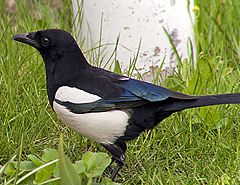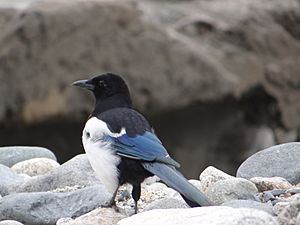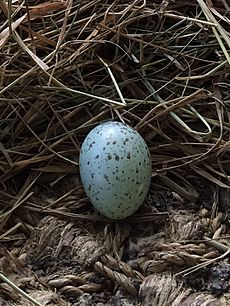European magpie facts for kids
Quick facts for kids European magpie |
|
|---|---|
 |
|
| Scientific classification | |
| Kingdom: | |
| Class: | |
| Order: | |
| Family: | |
| Genus: | |
| Binomial name | |
| Pica pica |
|
The European magpie (Pica pica) is a clever bird found across Europe, most of Asia, and parts of northwest Africa. It belongs to the crow family, which also includes crows and ravens. When people in Europe say 'magpie,' they usually mean the European magpie. It's the only type of magpie found in most of Europe, except for the Iberian Peninsula (Spain and Portugal).
Contents
About the European Magpie
Adult European magpies are medium-sized birds. They are about 44 to 46 centimeters (17 to 18 inches) long. More than half of this length is their long tail! Their wings can spread from 52 to 62 centimeters (20 to 24 inches) wide.
Magpies have shiny black feathers on their head, neck, and chest. These feathers can look green or purple in the light. Their belly and shoulder feathers are pure white. Their wings are also black with green or purple shine. When they fly, you can see white parts on their wing feathers. Their long tail is black with green and reddish-purple colors. Magpies have black legs and beaks, and dark brown eyes.
Male and female magpies look similar, but females are a little smaller. Males usually weigh between 210 and 272 grams (7.4 to 9.6 ounces). Females weigh a bit less, from 182 to 214 grams (6.4 to 7.5 ounces). Young magpies look like adults but are not as shiny. Their tails are much shorter.
Magpies have a well-known call. It sounds like a quick, chattering "chac-chac" or a repeating "chac-chac-chac-chac." Young magpies also make this sound. They can also make a sharp "Uik Uik" sound, which might remind you of a small dog barking.
Where Magpies Live
The European magpie lives in many places across Eurasia. You can find them from Spain and Ireland in the west to the Kamchatka Peninsula and Taiwan in the east. They also live in northwest Africa and on islands in the Mediterranean Sea. Some magpies were brought to Japan, specifically to the island of Kyūshū.
Magpies like open areas with scattered trees. They usually don't live in places with no trees or in very dense forests. However, you can often see them in cities and suburbs, like in parks and gardens. They can even live close to city centers.
Most magpies stay in the same area all year round. They spend winters near their nesting spots. But magpies living in very cold northern places, like Sweden, Finland, and Russia, might fly south when the weather is very harsh.
Magpie Behavior and Life Cycle

Reproduction and Nesting
Some magpies start having babies after their first year. Others wait until their second year. Magpies usually mate for life, meaning a pair stays together for many years. They often use the same territory for nesting each year.
Mating happens in the spring. During courtship, male magpies quickly raise and lower their head feathers. They also open and close their tails like fans and make soft calls. They spread their white shoulder feathers to attract females. After this, they might have short, playful flights and chases.
Magpies build large nests, usually in tall trees. They firmly attach their nests to a main branch. The nest is made of sticks held together with earth and clay. Inside, it's lined with fine roots. On top, they build a dome of prickly branches with one hidden entrance. These big nests are easy to spot when the leaves fall from the trees. If there aren't many trees, magpies sometimes build nests in bushes or hedges.
Eggs and Chicks
In Europe, female magpies usually lay their eggs in April. They typically lay five or six eggs, but sometimes as few as three or as many as ten. Eggs are laid early in the morning, usually one each day. On average, a magpie egg is about 3.3 by 2.3 centimeters (1.3 by 0.9 inches) and weighs about 9.9 grams (0.35 ounces). The eggs are usually pale blue-green with small brown spots, but their look can vary a lot.
The female magpie sits on the eggs for 21 to 22 days to keep them warm. The male magpie brings her food while she is on the nest. When the chicks hatch, they are almost naked and their eyes are closed. The female keeps them warm for the first 5 to 10 days. Both parents feed the chicks.
Chicks open their eyes about 7 to 8 days after hatching. Their body feathers start to grow after about 8 days, and their wing feathers after 10 days. For several days before they are ready to leave the nest, the chicks climb around on nearby branches. They usually fly out of the nest when they are about 27 days old.
After leaving the nest, the parents continue to feed the chicks for several more weeks. They also protect the young birds from dangers, as the chicks are not very good at flying yet. On average, only 3 or 4 chicks from a nest survive to fly successfully. Sometimes nests are lost to predators. Another reason chicks might not survive is not getting enough food. Magpie eggs hatch at different times, so if there isn't enough food, the last chicks to hatch might not make it. Magpies usually only raise one group of chicks each year.
A study in Britain found that only 22% of young magpies survived their first year. For adult magpies, about 69% survived each year. This means that magpies who make it past their first year live for about 3.7 years on average. The oldest recorded magpie lived to be 21 years and 8 months old!
What Magpies Eat
Magpies are omnivores, which means they eat both plants and animals. Their diet includes young birds and eggs, small mammals, insects, and leftover food scraps. They also eat dead animals, acorns, grains, and other plant materials.
Magpie Intelligence
The European magpie is considered one of the smartest birds, and even one of the most intelligent animals overall. Like other corvids (crows and ravens), their brain size compared to their body size is similar to that of great apes (like chimpanzees) and dolphins. This suggests they are very smart.
Scientists believe that corvids, including magpies, are as intelligent as great apes in many ways. This includes how they understand social situations, solve problems, adapt to new things, imagine, and plan for the future.
Magpies have been seen doing complex social rituals, which might even include showing sadness. They are also one of the few animals, and the only non-mammal, known to recognize themselves in a mirror. This shows a high level of self-awareness.
The intelligence of magpies suggests that smart brains can develop in different ways in different animal groups, like in corvids and in primates. Magpies show their intelligence by using tools, hiding and storing food for later, and remembering past events. They also use their own experiences to guess what other magpies might do. Another smart behavior is cutting their food into pieces that are just the right size for their young.
In zoos or with people, magpies have been seen counting to get food. They can even imitate human voices and regularly use tools to clean their own cages. In the wild, they work together in groups. They use clever plans when hunting other birds or when facing dangers.
Magpie Emotions
Some experts, like Marc Bekoff from the University of Colorado, believe that European magpies can feel complex emotions, including grief or sadness.
Magpie Population and Status
The European magpie lives in a very large area. In Europe alone, there are an estimated 7.5 to 19 million pairs of magpies. When you include magpies in other continents, the total population is thought to be between 46 and 228 million birds.
Since 1980, the number of magpies in Europe has stayed steady. There is no sign that their numbers are seriously going down. Because of this, the International Union for the Conservation of Nature (IUCN) says the European magpie is a species of "Least Concern." This means they are not currently at risk of disappearing.
Magpies and Humans
Traditions and Beliefs
In Europe
For a long time in Europe, magpies were often seen as bad luck. This was mostly because of old stories and beliefs. Some people thought that large black birds, like crows and ravens, were evil in British folklore, while white birds were good. Since magpies are black and white, they got caught in this idea.
In European folklore, magpies are linked to many superstitions about bad fortune. An old saying from the 1800s goes: "A single magpie in spring, foul weather will bring." This belief came from the idea that magpies only looked for food together in pairs when the weather was good. In Scotland, if a magpie was seen near a house window, it was thought to mean someone would die.
In Britain and Ireland, there's a popular children's rhyme called One for Sorrow. It says that seeing magpies can predict the future, depending on how many you see. There are many different versions of this rhyme.

In Italian, British, and French stories, magpies are believed to love shiny things, especially jewels or metal objects. The Rossini opera La gazza ladra (The Thieving Magpie) and The Adventures of Tintin comic The Castafiore Emerald are based on this idea. In countries like Bulgaria, the Czech Republic, Germany, Hungary, Poland, Russia, Slovakia, and Sweden, the magpie is seen as a thief. In Sweden, it's also linked to witchcraft. In Norway, magpies are thought to be clever and sneaky, but also connected to the "huldra," who are underground people.
Magpies have sometimes been disliked because they eat the eggs and young of other birds. However, scientific studies have shown that magpies do not actually cause the total number of songbirds to go down. In fact, some studies found that songbird populations even increased in places where there were many magpies. This means magpies don't have a negative impact on the overall songbird population.
In Asia
The way people see magpies in Europe is very different from how they are seen in Korea. In Korea, the magpie is celebrated as "a bird of great good fortune." It's seen as a symbol of strong spirit and bringing good luck and growth. Similarly, in China, magpies are also a sign of good fortune. The Chinese word for magpie even includes a character that means "happiness."
Images for kids
-
Magpie nest.
See also
 In Spanish: Urraca común para niños
In Spanish: Urraca común para niños







